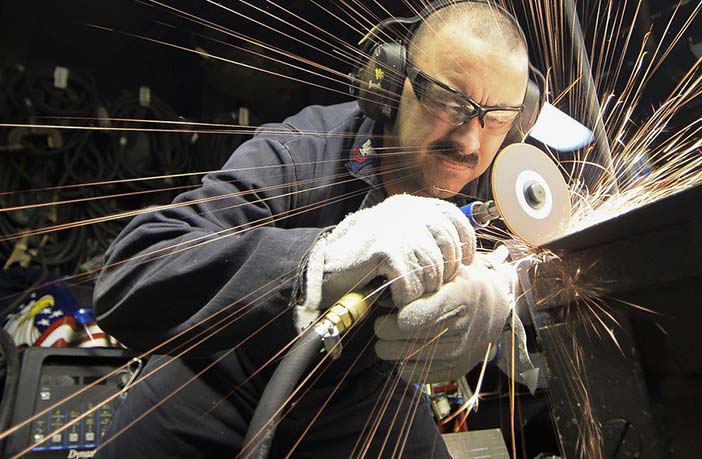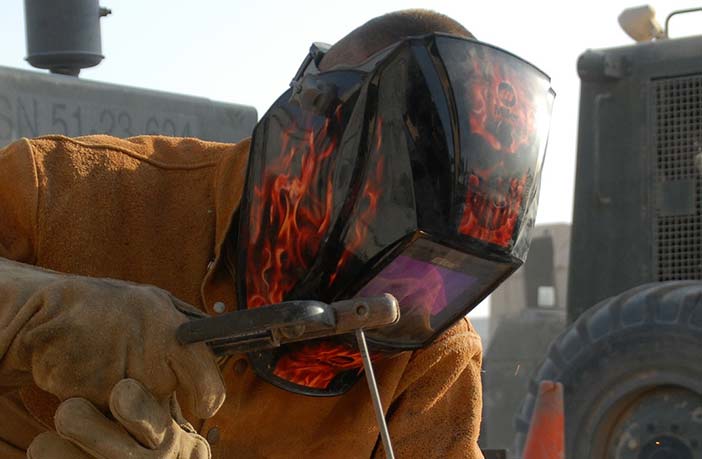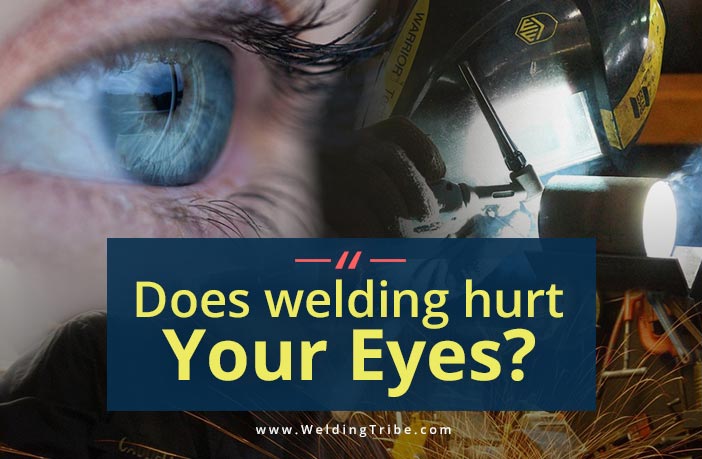Welding can pose safety hazards for the welders and even those who work nearby the workshop. A major reason for this is due to the extremely bright light coming from the arc itself. So the question pops into our mind “does welding hurt your eyes?”.
Yes, welding can cause damage to your eyes because of exposure to ultraviolet (UV) rays and flying metal debris. Among the common eye injuries, welder’s flash (or Photokeratitis) is reversible but some others can cause permanent damage to your vision. Even though most of these injuries are temporary, the pain can be intense. So wearing proper safety gear is a smart thing to prevent in the first place.
Vulnerability and fragility make eye injuries to become the most severe in some cases. As per the latest research, welding and grinding contribute to around 29% of the total eye injuries in the world.
Those working at industries that produce fabricated metal products, commercial and industrial machinery are at higher risk for eye injuries related to welding. In this article, we will take a closer look at how welding can potentially damage your vision, and most importantly how you can prevent it.
Let’s get started.
Why does welding hurt your eyes?

Welding can damage your eyes by absorbing radiation from the bright light produced at the tip of the electrode. Even though it looks like just an extreme light source, it carries radiation such as ultraviolet, infrared and other visible spectrum radiation. Some of these rays have the potential to reach your retina hence making them extremely harmful for looking directly at with the naked eye.
The dangers of UV rays
Infrared rays itself can not make a huge impact on the eye to cause damage but UV rays can do significant damage. For example, ultraviolet radiation (UVR) can get absorbed in your eyes’ cornea and lens, hence leading to swollen, painful eyes. Eye damage resulting from this process is what’s referred to as welder’s flash or photokeratitis.
Generally, photokeratitis refers to the sunburn of the cornea. Fortunately, this eye impairment is not permanent, but the pain can become severe over time. It may look like you’re fine at first but after a few hours, you will start to feel the consequences of that. There are some cases where it will take you a few days and nights for the eyes to get better. If the flash burns not treated quickly, infections can occur which leads to worse situations.
Somehow if you continue exposing your eyes to ultraviolet radiation, the eyes’ cornea and lens can end up yellowing over time. With this condition, you will find it hard while struggling with contrast in your vision, hence the main long-term effects of welding on eyes.
Types of UVR & how they affect your eyesight

Ultraviolet radiation can be divided into 3 types. UVA, UVB, and UVC (Has the shortest wavelength).
Here UVC radiation is the most harmful to the eyes, but getting exposed to UV radiation from time-to-time can lead to pinguecula and pterygium (Surfer’s Eye). Here, pinguecula and pterygia refer to the growths on the eye’s surface, which end up affecting the cornea and distorting vision.
Yes, UVA radiation is less intense and features longer wavelengths compared to UVB radiation, but it’s capable of passing through the cornea to the eye’s lens. It is possible for the infrared and UV radiation that penetrates your eye to reach the retina, hence causing damage.
Even though you wear your safety gear, sometimes you still feel eye soreness. This can be due to concentrating in a smaller area for a long time throughout the day. It’s not permanent but you can do some eye exercises to make sure it will not affect your vision in the long term.
Can welding cause eye floaters?
YES! The light at the center of where the welding is carried out is so intense if you look at it directly, sometimes you will see dark spots in your vision.
This is a similar phenomenon just like when you look at the sun directly it leaves you with dark eye floaters. Beware if you look at the welding point closely it can lead to permanent eye injuries.
Radiation is not the only thing that can ruin your eyes

Several other welding-related tasks can fling metal chips into the atmosphere, all of which can cause damage to your eyes if they remain unprotected.
Let’s start with the cutting tools such as chop saws and band saws. Flying debris sent by electrical saws has the capacity of emitting projectiles. Grinding and hammering are other activities that are likely to hurt your eyes this way. Small metallic foreign bodies can come into contact with your eyes as you grind a metal surface with an angle grinder.
Other hazardous tasks that can expose you to the same risk include notching, buffing, and sanding pipe. Also, the intense heat generated by arc welding, and rare explosions resulting from gas welding can affect your eyes. Wearing safety goggles at all times is highly recommend if you want to avoid these accidents.
Rust ring
For some reason, if a metal particle gets attached to your eye you have to take immediate actions. The main reason is, you need to avoid the formation of a rust ring in the eye.
When a foreign metal body embeds in the eye, it will start to form rust within a few hours. Salt in your tears is the reason for this quite fast reaction. It is essential to remove the foreign body as early since it can lead to necrosis (The death of cells in a tissue) which can lead to permanent vision impairment.
Statistics to prove that eye injuries related to welding are NO joke!
Eye injuries are day-to-day issues in the manufacturing industry. They are the significant causes of unilateral blindness in the entire world.
For example, US records around 2.4 million ocular injuries per year. Mostly, the victims get these injuries while on with their daily duties in various industries. Eye injuries remain to be a threat despite the well-publicized standards related to industrial protection even in developing countries.
Welding is the primary occupation that records a high percentage of eye injuries in the world. It results in eye damage because of a wide range of factors that we discussed earlier in this article.
Studies show a high incidence of eye injuries because welding activities have increased over time, as opposed to decreasing. The key reason behind this is the increasing industrialization.
Two researchers have done an in-depth study on “Ocular injuries among industrial welders” that revealed some shocking results.
From 500 welders selected, flying metal chips accounted for most eye injuries (68.15%) and arc rays accounted for (31.85%).
By B Fiebai and EA Awoyesuku
After examination of these statistics, it’s clear that molten or cold metal particles are the most common reason for eye injuries and awareness programs can minimize the percentage of these types of injuries among industrial welders.
Types of eye injuries related to welding
Arc Eye (or Welder’s Flash)
Arc eye is simply an inflammation of the clear tissue over the eyeball — also called cornea. Ultraviolet radiation can lead to the degeneration of this thin tissue and cause damage to the ocular surface.
Some of the apparent symptoms associated with arc eye include excessive watering and blinks, a gritty feeling in your eyes and feeling painful whenever looking at the bright lights. Other symptoms include blurred vision and swelling of the eyes.
“Welder’s eye”, “Photokeratitis ” or “Ultraviolet keratitis” are some other terms used for this condition.
The generated bright light from the welding arc can temporarily blind your eyes. This condition happens whenever the iris muscles do not close the eye’s pupil fast enough or far enough to stop some light from accessing the retina.
Don’t expect to see the symptoms of welder’s flash for several hours after the interaction with ultraviolet light. However, there are high chances for even milliseconds of exposure to UV light to affect your eyes.
The time you take to experience the symptoms will depend on several factors. These include the intensity of the welding radiation and your eye’s strategic position from the welding arc. Others include the type of eye protection you’re wearing and the direction from which the radiation penetrates your eye.
Blue light hazard
There are high chances for visible light to cause retinal damage, a condition known as blue light hazard. Electromagnetic radiation which has wavelengths between 400 to 500nm or high-frequency light waves can do some serious damage to the retina’s sensitivity. This issue can cause temporary or permanent damage to the retina, hence leading to blindness.
Macular degeneration and cataracts
Macular degeneration and cataracts are the long-term effects of welding on eyes. These cumulative adverse effects happen for some welders who get exposed to UV light for an extended period. If you get exposed to UV rays a lot while you are at a younger age there’s a high chance of you to have Age-related macular degeneration (AMD).
On the other hand, cataracts are highly unlikely to be occurred due to welding, but there’s still a possibility. A clouding will generate in the lenses of your eyes blocking the vision. It’s preventable but there are high chances for cataracts to lead to blindness if you don’t seek medical attention.
How to treat your eyes if they get hurt during welding
It is possible to have a flash burn if you accidentally looked at the welding arc.
So, what do you need to do if this happens?
Even though your eyes are the fastest healing tissue in your body you have to know the first aids for this kind of emergency.
First, do not interfere with your eyes. Yes, it may feel better to rub and itch your eyes within the first few seconds, but this will prolong the symptoms and even cause corneal scarring. As an alternative, go to a dark room and open your eyes if you can. Try to relax, although it’s hard to so under your condition. Avoid wearing contact lenses, watching a TV or any related stuff.
If it’s painful take a pain-relieving medication such as paracetamol. Consider seeking medical advice if the pain persists after this process.
Welder’s flash burn home remedies
Other than medical aid, some home remedies can help in speeding up recovery from welder’s flash (Arc eye). They include:
Potatoes
Potatoes provide a cooling effect and minimize inflammation around the damaged eye. Therefore, they are essential in reducing pain and relieving irritation and itchiness.
Milk
The natural enzymes present in milk are vital in taking care of the dryness and itching that relates to welder’s flash. It’s crucial in lubricating eyes and relieving pain to some extent.
Tea bags
Tea bags contain tannins which are essential in reducing inflammation in the next minute after their application. Their coolness also helps in alleviating the pain that results from the welder’s flash.
Ice pack
The temperature of ice packs helps a lot in cutting pain and sensation in the affected eye. Also, they are essential in reducing redness and inflammation.
Cucumber
Cucumber contains a higher percentage of water, which helps in offering deep moisturization to the area that’s affected.
Rosewater
Rosewater is a coolant that alleviates irritation and sensation of pain to a great extent.
Almond oil
Almonds contain a higher percentage of vitamin E nutrients, hence working as a lubricator for the affected eyes. Also, they reduce the burning sensation, eye fatigue, and inflammation.
Wet cloth
A wet cloth enhances relief from the swelling, and pain felt because of welder’s flash.
Banana
Banana contains vitamin B2, which helps in healing inflammation and eye fatigue. Also, it protects eyelids flaking and dryness by lubricating them.
Castor oil
Cator oil controls tears’ evaporation and enhances the production of lipids in the eyes.
How To Prevent Eye Injuries During Welding
A welding helmet made according to ANSI standards (ANSI Z87.1+) is a must if you need to protect your eyes from ultraviolet, infrared rays and even molten metal particles.
Safety glasses on at all times under the helmet will give an extra layer of protection under UV light and flying debris.
The welding helmet’s shade is another essential area where to concentrate when welding. Choose a shade that matches the task you want to perform.
Remember, there are two main types of lens shades that a welding helmet can have.
- Variable lens shade (also called auto-darkening lens shade)
- Fixed lens shade
Choosing the right welding lens shade

For the fixed shade welding helmet, it works best for those welders who perform similar welding projects. On the other hand, a variable shade welding helmet works best for those welders who perform different welding tasks.
You should always start with the darkest level lens shades whenever selecting the most appropriate ones. After this, you can adjust slowly to the manual or automatic ones, until you achieve the accurate view of the area. However, as a welder, you should not be ready to get at the position below the required protective level.
Even if you’re standing from afar safe viewing distance your eyes can get harmed while not wearing any eye protection. The bright light coming from other welder arcs can still reach your eyes and potentially mess up your vision.
In conclusion,
I have to say, pay close attention to the safety of your eyes while welding. Eyes are the jewel of your body and it’s your responsibility to take care of those. Welding can affect your eyesight big time if you don’t follow the standard safety rules.
I have seen 70-year-old welders without any major eye impairments because they were consistently careful about their work — and you can be too. Even if you accidentally looked at a welding arc be sure to take first aid so you can avoid long term negative effects on your eyes.

hey guys its mason mcfarline here im going to hit that oxygen tank lmao
im joking btw
I’m glad you enjoyed this article Mason 🙂
Hello,
Thanks for your interesting article.
I want to know, is it necessery to have rest between the welding because of the eyes? is there any information about it?